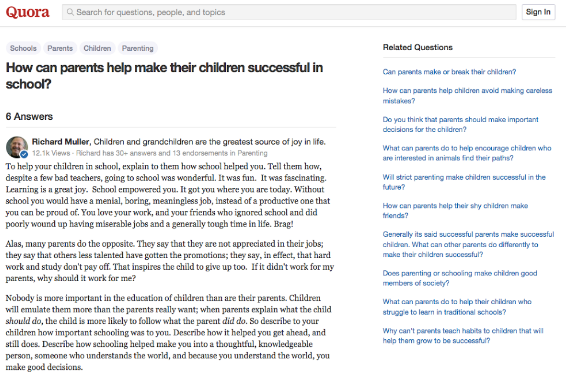Does the thought of constantly updating your school blog fill you with dread and intimidation?
You or your administrative team may have begrudgingly taken on the task of updating the school blog with fresh content to increase engagement with potential and current parents.
But if you’re pressed for time (always!) it can be a monumental challenge to come up with blog topics, write the actual content, look for pictures, post about the blog on social media… you get the idea.
So how can you take advantage of all the positive awareness your blog will bring your school without overloading yourself with tons of work?
Streamline the process.
Once you find the right themes and categories for your school blog, you’ll never have to struggle to find share-worthy content. Plus, the easier (and faster) the process becomes, the more likely you’ll be to keep going.
All you have to do is lay out a plan for success, establish a routine, and stick to it consistently.
Trust us, you and your team will be mastering the blogosphere with your eyes closed after you read our helpful tips today.
[content_upgrade cu_id=”6296″]Bonus: Learn how to use your themes and categories to create your blog’s editorial calendar in less than 30 minutes. Subscribe now to receive this free guide![content_upgrade_button]Click Here[/content_upgrade_button][/content_upgrade]
Here’s Why Your Blog Needs Themes and Categories
It may be tempting to dive right into blog topics, but it’s so important to take the time to plan out the direction of your blog because:
You’ll Have a Stronger Message
Blogs that lack focus or direction are weaker than those with strong themes. Give your blog a point of view and use your content to support that.
For instance, a college prepatory school would probably find a way to give parents and students everything they need to get into their dream school, while also highlighting the achievements of juniors and seniors to boost their chances of receiving scholarships.
This helps the school build authority and shows potential parents what staff members are truly focusing on.
You’ll Come Up with Content Easier and Faster
Instead of blindly waiting for inspiration to strike (newsflash: it will only happen when you’re brushing your teeth or in the shower), create a list of themes and categories to give your team an umbrella of topics to choose from.

Let’s say you decide to make technology one of your school’s themes.
Every time you need to create blog topics, you’ll always know that you need one in the realm of technology. You can choose any topic in the technology world as long as the content connects with parents and students.
You’ll Be Able to Assign Content
You don’t have to take on all the blog’s content creation alone—share some of the responsibility by creating a rotating theme or category.
Play to your team’s strengths. If one person on your team always makes the best treats for the bake sale while another’s always on the hunt for budget-friendly activities, assign them each different categories to divide the work and conquer.
Consider assigning posts to teachers with different backgrounds, messages, or interests to share. These could be stories about what led them into teaching, what made them choose their majors, what they’re currently working on, etc.
Create a category to profile exceptional students, or news about lesser-known sports teams and clubs, and ask moderators to participate.
When everyone feels like they can contribute their expertise and knowledge, they’ll be more likely to help and produce quality content for your school.
Parents Will Become Regular Readers
Your readers will happily subscribe to your newsletter so they never miss an update, they’ll comment and interact with other readers, and hopefully share your blog post with their social media followers.
All of this will do wonders to boost traffic to your blog and website—not to mention keep parents engaged with everything going on at your school.
On the other hand, if your content doesn’t resonate with your ideal readers and misses the mark, you’ll see less blog views, comments, and shares on social media. Take this opportunity to reconvene with your team and brainstorm about which ideas are working and which need to be tossed to make room for better themes.
Speaking of themes, what’s the secret to choosing the right ones?
How to Find Blog Themes and Categories Parents Love
You’ll want to create 5–7 broad categories based on information or issues that your target audience needs help with. Then you’ll use these categories to come up with very specific topics to blog about.
For each category you create, add a one sentence description to justify it. Make sure your ‘why’ answers questions like: Why would my reader care about this? or Why would this be valuable to my reader?
Here are a few ways to brainstorm the best themes and categories:
Take a Stand
If your school is passionate about a social cause, such as ending childhood obesity or volunteering, use your blog to promote content relating to the awareness of your chosen issue.
Assigning a category means you’ll always have room to squeeze in content that matters and reinforces your mission during each topic refresh.
Use Your Target Audience for Inspiration
Never forget who you’re writing your blog posts for. This is what’s known as your target audience. Your number one goal should be creating content that your target audience finds useful, relevant, and interesting.
To find out what parents want to read, ask your team to think about the challenges and problems they’re currently facing.

Using a spreadsheet, or a good ol’ fashioned piece of graph or loose leaf paper, create a chart with three columns. Title one of the columns INTERESTS; title the second column CHALLENGES; and the third NEEDS.
Brainstorm with your team and add as many issues to the list as you can.
Think about the questions your team fields from parents, or what they’re chatting about on social media. Think about the struggles they face as parents, and the obstacles school sometimes inadvertently creates for families.
When you get all the ideas out, try to group them into themes or categories. See if you can spot corresponding ideas in this example:
- Interests: spending time together as a family, saving money
- Challenges: finding activities, not spending money, staying local
- Needs: family-friendly activities, local event info, budget travel tips
Using these ideas, you can create a theme or category such as Family Friendly Local Activities to encompass all of these points.
Check Online Forums (They’re Not Scary!)
Online forums are where people ask questions and users with expertise respond with their answers.
Using online forums such as Quora is a great idea because you’ll be able to see exactly which questions parents need the most help with.
As you can see from this screenshot, you can search for questions by topic (i.e., school, parents, education, etc.) and see all of the answers from previously asked questions. You can even check out a list of related questions to further your research:

These questions will not only help create your blog’s categories, they’ll also give you inspiration for your blog topics as well.
When you create your blog’s themes, you’ll be ready to brainstorm specific topics your team wants to tackle. Try to come up with one topic for every category you have and you’ll be on your way to creating an editorial calendar for your blog.
Create 6–8 topics at a time if you want to publish around two articles a month. This gives you a three month supply of posts. Your team will be in the swing of things after this so the next time you need a topic refresh the process will go much faster.
Although it may seem productive to knock out a list of topics for the year, what seems relevant now may not be in the next six months. Refresh your article list every three months to ensure that your content is always fresh.
If you’re looking for inspiration for blog topics, don’t forget to check out our other post, 4 Easy Tips for Keeping Your School’s Blog Interesting, for more helpful resources!
[content_upgrade cu_id=”6296″]Bonus: Now that you know why you need themes and categories for your blog, find out how to make an editorial calendar – the unsung hero of every successful blog – with this free helpful guide![content_upgrade_button]Click Here[/content_upgrade_button][/content_upgrade]

